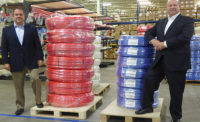Supply House Times Profile: McWane Plumbing Group and AB&I Foundry
Company believes manufacturing in U.S. creates jobs, assures quality.

McWane Plumbing Group Executive Vice President Kurt Winter. Along with AB&I Foundry, companies in the McWane Plumbing Group include Tyler Pipe & Coupling; Anaco (Husky); Wade Drains; and Bibby Ste. Croix. Photo courtesy of McWane Plumbing Group

AB&I Foundry is committed to the distribution channel. “Wholesalers are our direct customers,” General Manager and Vice President of Sales Michael Lowe (pictured) says. “We have exclusive distribution, so everything begins with them.” Photo courtesy of McWane Plumbing Group


Supply House Times recently interviewed McWane Plumbing Group Executive Vice President Kurt Winter and AB&I Foundry General Manager and Vice President of Sales Michael Lowe at the AB&I facility in Oakland, Calif. Along with AB&I, companies in the McWane Plumbing Group are: Tyler Pipe & Coupling; Anaco, which includes the Husky brand; Wade Drains; and Bibby Ste. Croix.
Before being promoted to his current position last July, Winter served as McWane Plumbing Group vice president and AB&I general manager. Lowe, also promoted July 1 of last year, had been AB&I’s vice president of sales.
Supply House Times: What is the primary common denominator AB&I shares with other companies in the McWane Plumbing Group?
KW: The most visceral common denominators a team member in every McWane facility eats, sleeps, and drinks are safety and environmental awareness.
ML: All our companies’ products relate to DWV — drain, waste and vent. Tyler Pipe makes cast-iron soil pipe fittings, as we do. Anaco/Husky and Tyler Couplings are the joining systems. Wade Drains is the drain system, and Bibby is a cast-iron soil pipe manufacturer in Canada.
Another common denominator is we have personal relationships in the plumbing distribution channel with engineers, inspectors, distributors and contractors. We try to get out in the field to create a personal rapport. For me, that means being very visible. It means being responsible and giving back to our industry in terms of the time and energy we spend working on codes and standards. Some of these efforts have very little to do with our product, but we try to be very good stewards toward the industry that we participate in. We are bringing in a new generation of people to do that. The other thing is we have a common leader in Kurt.
Supply House Times: Why is it important for plumbing engineers, contractors and distributors to support companies manufacturing products in the United States?
ML: It’s jobs, certainly. Not only the direct jobs that support the economy of our manufacturing plants and our manufacturers reps but also all the related jobs of our customers. There’s a multiplier effect for our customers and vendors’ jobs of four or five to one that we generate for the economy. The other factor is quality. Although you can manufacture quality products anywhere, and China can make good products, they often make products that don’t pass muster. In the United States, you have a higher quality assurance that it’s going to be done right. That’s not to say the industry is prohibitive toward imported products. It’s just that in the U.S., we have regulators of quality and the scrutiny is much greater. In other countries, it’s hit and miss.
Supply House Times: Why is McWane so proud of its safety record?
KW: Our investment in safety is staggering. Whereas one person was able to perform the safety functions of a facility 10 years ago, each of our plants now has a full safety department with a staff of four or five. They make sure that all OSHA requirements are met, and that all safety processes and training are taken care of. The tradeoff is it’s become more complex and a bit more bureaucratic. We have to file many public reports. But what we get for that is a safer foundry.
And that’s important. We’re dealing with of 2,700-degree molten metal. We’re proud to say that on the safety side we are below all industry benchmarks for recordable incidents and days away from work by our team members. We beat it by a factor of 25 times. And if a facility is not able to fulfill those requirements within the McWane organization, that facility will have a tremendous amount of personnel turnover. If people aren’t committed to the safety aspect of the McWane philosophy, then we can’t make anything.
Supply House Times: Why does AB&I invest so heavily in its environmental programs?
ML: Environmental stewardship is one of our core beliefs. As a foundry in California, we are held to a much higher standard than anyone else in the world, and we exceed that in a good way.
When we talk about the environment, we have to meet the national standards of EPA and OSHA. The next level up for regulations is California’s state OSHA and EPA. We have to maintain environmental processes that are far in excess of what other parts of the country have to do. We are under a microscope here in the Bay Area and we invest millions of dollars in compliance. We have awards for our environmental performance. The Bay Area Air Quality District has a very favorable view of us. When we do our job well, they acknowledge it.
KW: I would add that we are a major recycler; we manufacture cast-iron products from recycled post-consumer metal. Building owners can get LEED points using our product in their building. So, while we are involved with LEED and the U.S. Green Building Council, a majority of our customers don’t really take advantage of that. We do see companies that build their buildings up to the LEED standard, but they’re not actually going through the LEED process because of the expense and paperwork involved.
Supply House Times: In what market sectors do you see growth for plumbing engineers, contractors and distributors?
ML: Multifamily housing in urban environments is hot, and it has been for a while. Health care has been good, too. Specifically, San Francisco, the West Coast, New York City, Boston and Miami are hot developing urban areas. Some markets are doing better than others.
Very rarely does our product go into single-family homes except for higher end homes where owners want to spend the extra hundred dollars to make sure they don’t hear the toilet flush.
Supply House Times: What innovations can plumbing engineers, contractors and distributors expect to see from AB&I?
ML: We are very innovative with the manufacturing process vs. technology innovations of our product. Our pipe machines are homegrown and faster than anyone else’s. We do many innovative things to manufacture as much product as larger foundries on a much smaller footprint.
KW: We strive to improve product quality while reducing costs and cycle time. Our goal is to make product faster and less expensively, all the while being safe and environmentally compliant.
It’s all about efficiency and pulling labor out of the process because that’s such a huge cost component in manufacturing. So, we hit a lot of singles, I would say. What we may see as a dramatic innovative tweak here, our customers may not even realize what we did for them. The heavy-duty coupling we’ve given them is a product that’s going to perform better, but all they see is the exact same thing they did two years ago. They may not see this is a coupling we just improved, and instead of withstanding a 3.0 or 4.0 earthquake, it’s going to survive a 7.0 earthquake. In a sense, we give all that to them for free.
Supply House Times: Why do you believe teamwork is so important in today’s business environment?
KW: We’ve embraced the team concept. And even though we make a very basic product, it is a very complex industry. And it’s getting even more complex with more competitors, countries and new technologies involved. For one person to think he can run this company without a competent, highly functioning team is fooling himself. There’s just too much at stake.
If we don’t cast a wide net within our team to get different inputs on the table when we all get together, we’ll get run over. Nobody’s afraid to challenge anybody here. But at the end of the day, we have a strategic direction, and everybody has a very vital part to play in that.
Everything has become so incredibly specialized in our industry, whether it’s our production process or something as seemingly trivial as pipe coating. So, we call on all our experts. At any given point, our management steering team is talking with 15 or 18 people who all have expert opinions on markets, customers, product, service delivery or whatever.
ML: We have no employees, we are all team members. Team is a mantra, it’s what we are. It’s an overused cliché but the whole is greater than the sum of the parts. If we can get everyone working in a common direction, we can go much further than we can with a bunch of individual superstars.
We talk about having a culture of owners. The guys on the foundry floor and in the field own the company. Management is here to support them in getting the tools they need to run their business the best way possible. We’re not top down; we’re driven by the people closest to the action.
Supply House Times: What was your first order of business when you were named general manager of AB&I?
ML: I held a town hall meeting to explain to the team that my job is to support the team. I then started having one-on-ones with everybody in the foundry to get to know the team. I promised that by the team’s annual celebration in December I would meet with everybody in the entire company. That’s 206 people divided by five months. My math says that’s about two meetings a day.
Supply House Times: How important is McWane’s relationship with the wholesale distribution channel?
ML: Committing to a relationship with the wholesale distribution channel is extremely important. Wholesalers are our direct customer. We have exclusive distribution so everything begins with them. But we are increasingly focused on our relationships with other parts of the channel as well – from inspector to engineer to code official to contractor. We have to stay relevant to everyone. We can’t just leave it all up to our manufacturers reps to do, although we rely heavily on their support.
Supply House Times: In what new ways is McWane connecting with plumbing engineers, contractors and distributors?
KW: We have all our systems on CAD and Revit drawings because many engineers use them. While engineers aren’t our direct customers, we’ve invested a lot in educating engineers about our product. We believe if we can make our product easier for our distributor customers to sell, then we’re going to invest in it. Another factor is we’ve got a generation that’s aging and a new generation coming in. We’re trying to stay relevant to both groups and provide them with whatever documents they need, whether it is a digital drawing or a print catalog, old school and new school.
ML: We invest quite a bit in in educating the industry. We support plumbing the PHCC’s plumbing apprentice program, for example. Our tech service team also is focusing on engineers and inspectors across the country. From a sales perspective, we’re trying to diversify our sales team and our technical services team to reach the millennial generation and to stay relevant to baby boomers and gen Xers. There are some differences in the way those generations look at the world, and we need to recognize that.
Supply House Times: If you had one piece of business advice to give to plumbing engineers, contractors and distributors, what would it be?
ML: Prepare for the future. You have to appeal to the business leaders of the future, and the millennials will be the business leaders any moment now. What that means is you have to be technology savvy and give them a sense of belonging. You need to create a culture where they feel like they are part of something bigger than themselves. And you have to give them some sort of work-life balance. I hope the baby boomers understand that. Baby boomers and gen Xers live to work. The millennials, as strange as it might seem to us, work to live. There’s a talent shortage now and it’s only going to get worse as the baby boomers retire. Tomorrow will be here very quickly.
This article was originally titled “Personal touch” in the January 2017 print edition of Supply House Times.
Looking for a reprint of this article?
From high-res PDFs to custom plaques, order your copy today!








